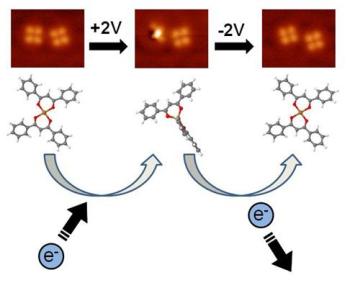Researchers at the center for materials elaboration and structural studies, (CEMES) have found a connection between a molecule's geometrical shape and its charge, which makes it useful for an electromechanical system with nanometric dimensions.
It is possible to manufacture ultra-dense digital memory or nanomotors using the easy-to-control back-and-forth movement at the molecular level and the results of the research were published in Physical Review Letters.
The researchers at the CEMES have designed a molecular switch that can switch between two states due to the impact of an external stimulus. In this particular experiment, the two states which may be considered as state A and state B relate to two different molecular geometries. The shape of the molecule varies but the composition remains unaffected. The change is induced by adding an electron to the molecule, which acts as the external stimulus. The addition of an electron also generates a repelling force, causing specific atoms to move away from each other enabling modification of the molecule from a flat, square shape to a pyramidal shape.
 Diagrams showing the molecule's geometry as a function of its charge state
Diagrams showing the molecule's geometry as a function of its charge state
The process is made feasible with the use of a scanning tunneling microscope (STM), which serves a dual purpose as a camera to show the shape of molecule and as an instrument to inject electrons. When electrical tension is applied using the tip of the microscope, an electron is gained by the molecule and it takes on the pyramidal shape.
The operation can be reversed by the application of a reverse voltage, because of which the molecule emits the electron and switches back to a flat shape and assumes neutral charge. The CNRS researchers have tested the state of the molecule's charge in both arrangements using an atomic force microscope (AFM), thus proving the link between the molecule's geometrical shape and its charge.
This molecular switch can be used in a wide range of applications, such as the synthesis of basic memory units on a molecular scale. The molecule's ability to retain a charge and emit it could be utilized to encode binary data. It may also be possible to utilise the molecular switching concept to manufacture a nanomachine.